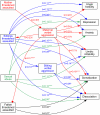Witnessing violence toward siblings: an understudied but potent form of early adversity
- PMID: 22216127
- PMCID: PMC3244412
- DOI: 10.1371/journal.pone.0028852
Witnessing violence toward siblings: an understudied but potent form of early adversity
Abstract
Research on the consequences of witnessing domestic violence has focused on inter-adult violence and most specifically on violence toward mothers. The potential consequences of witnessing violence to siblings have been almost entirely overlooked. Based on clinical experience we sought to test the hypothesis that witnessing violence toward siblings would be as consequential as witnessing violence toward mothers. The community sample consisted of unmedicated, right-handed, young adults who had siblings (n=1,412; 62.7% female; 21.8±2.1 years of age). History of witnessing threats or assaults to mothers, fathers and siblings, exposure to parental and sibling verbal abuse and physical abuse, sexual abuse and sociodemographic factors were assessed by self-report. Symptoms of depression, anxiety, somatization, anger-hostility, dissociation and 'limbic irritability' were assessed by rating scales. Data were analyzed by multiple regression, with techniques to gauge relative importance; logistic regression to assess adjusted odds ratios for clinically-significant ratings; and random forest regression using conditional trees. Subjects reported witnessing violence to siblings slightly more often than witnessing violence to mothers (22% vs 21%), which overlapped by 51-54%. Witnessing violence toward siblings was associated with significant effects on all ratings. Witnessing violence toward mother was not associated with significant effects on any scale in these models. Measures of the relative importance of witnessing violence to siblings were many fold greater than measures of importance for witnessing violence towards mothers or fathers. Mediation and structural equation models showed that effects of witnessing violence toward mothers or fathers were predominantly indirect and mediated by changes in maternal behavior. The effects of witnessing violence toward siblings were more direct. These findings suggest that greater attention be given to the effects of witnessing aggression toward siblings in studies of domestic violence, abuse and early adversity.
© 2011 Teicher, Vitaliano.
Conflict of interest statement
Figures





References
-
- Straus MA, Hamby SL, Finkelhor D, Moore DW, Runyan D. Identification of child maltreatment with the Parent-Child Conflict Tactics Scales: development and psychometric data for a national sample of American parents. Child Abuse Negl. 1998;22:249–270. - PubMed
-
- Straus MA, Hamby SL, McCoy SB, Sugarman DB. The revised conflict tactics scales (CTSZ): Development and preliminary psychometric data. Journal of Family Issues. 1996;17:283–316.
-
- Richters JE, Martinez P. Things I've seen and heard: An interview for young children about exposure to violence. In: Branch CaADR., editor. Rockville, MD: National Institute of Mental Health; 1990.
-
- Felitti VJ, Anda RF, Nordenberg D, Williamson DF, Spitz AM, et al. Relationship of childhood abuse and household dysfunction to many of the leading causes of death in adults. The Adverse Childhood Experiences (ACE) Study. Am J Prev Med. 1998;14:245–258. - PubMed
Publication types
MeSH terms
Grants and funding
LinkOut - more resources
Full Text Sources

